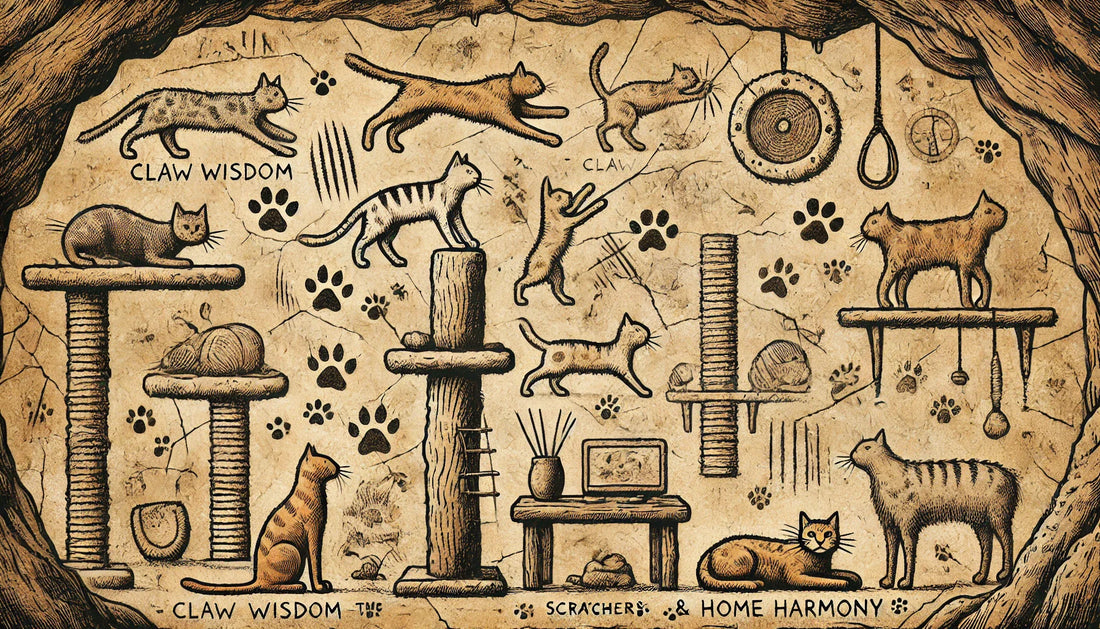
Claw Wisdom — The 2025 Guide to Scratchers & Home Harmony
Share
Scratching is not mischief; it is identity.
At Cat Emporium, we see every claw mark as calligraphy — a signature of instinct, scent, and stretch.
When you understand why your cat scratches, you transform chaos into choreography, and furniture becomes peace instead of casualty.
1️⃣ Form Follows Instinct
Vertical scratchers fulfill the need for a full-body stretch after rest.
Horizontal boards echo the feel of tree roots or woven rugs — perfect for ground scratchers.
Angled models offer compromise and variety.
Multi-cat households thrive when each room offers both vertical and horizontal forms.
Diversity of texture is harmony of instinct.
Q & A
Q: Why does my cat ignore the new scratching post?
A: It may be placed wrong, made of the wrong material, or feel unstable.
Location and texture matter as much as design.
2️⃣ Materials That Matter
-
Sisal fabric (not rope): Provides consistent grip and long-lasting fibers.
-
Corrugated cardboard: Delivers that satisfying “give.” Look for dense honeycomb cores.
-
Carpet: Comforting yet confusing — use selectively so rules remain clear.
-
Wood posts with replaceable sleeves: Balance beauty and endurance.
Cats read texture the way we read tone; choose wisely, and the claws will follow.
Q & A
Q: How often should I replace a worn scratcher?
A: When grooves deepen and fibers fray. Fresh resistance keeps the ritual rewarding.
3️⃣ Dimensions & Stability (Non-Negotiable)
-
Height: At least 30 in / 76 cm so adults can stretch fully.
-
Base: Broad and weighted — no wobble, ever.
-
Mounting: Wall-anchored options create vertical highways; secure them to studs or heavy anchors.
Cats abandon unstable stages. Their confidence relies on steady ground.
Q & A
Q: Is size more important than shape?
A: For confidence, yes. A tall, firm post gives dignity; too short, and the ritual loses purpose.
4️⃣ Placement Strategy
Position scratchers where cats live, not where you think they should.
Key locations: beside sleeping areas (post-nap stretch), near entrances (territorial cues), and next to forbidden targets (sofas).
For window lounges, pair a perch and scratcher — a “watch & stretch” sanctuary that turns habit into harmony.
Q & A
Q: My cat keeps scratching the sofa—what should I do?
A: Move a scratcher directly beside it, scent it with catnip or silvervine, and reward the correct choice instantly.
5️⃣ Training That Sticks
-
Prime new scratchers with silvervine or catnip two to three times weekly.
-
Never force paws; guide gently.
-
Reward instantly — praise or treat at the moment of success.
-
Protect furniture temporarily with double-sided tape or clear shields until habits solidify.
Positive association, not punishment, builds lifelong etiquette.
Q & A
Q: How long does retraining take?
A: Usually one to three weeks. Cats learn quickly when their environment speaks their language.
6️⃣ Maintenance & Rotation
Replace worn sleeves or panels when fibers loosen.
Rotate scratchers between rooms every few weeks to renew curiosity.
Sun-air cardboard briefly to refresh scent neutrality; launder fabric covers.
A well-kept scratcher is not décor — it’s dialogue maintained.
7️⃣ Harmony in Small Spaces
Compact living doesn’t mean compromise.
Use corner posts, wall-mounted boards, and combination towers (perch + post + hideaway).
Add low ramp scratchers for seniors or cats with limited mobility.
When form meets instinct, even a studio apartment becomes a kingdom.
🐾 Conclusion
To honor the claw is to honor the cat.
Offer height, texture, and certainty, and your home will hum with quiet confidence.
Scratching is not destruction—it is communication perfected through understanding.
At Cat Emporium, every design respects that dialogue — balancing your cat’s wild nature with your home’s serene design.
